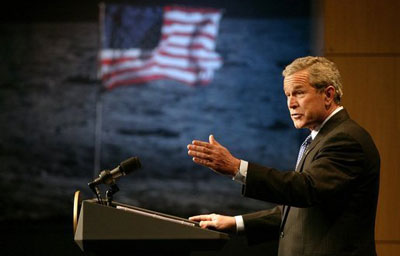The feminization of American space policyby Dwayne A. Day
|
| Reflecting a change that has happened in other areas of American politics, “masculine” language and imagery have been replaced by “feminine” language and imagery in the civilian space program. |
Lord was not the first person to notice this change in American politics. As early as 1988 Kathleen Hall Jamieson in her book “Eloquence in an Electronic Age” argued that modern presidents have adopted what she described as “the Effeminate Style.” When women first began to enter into politics, they learned that if they argued as boldly as their male opponents they were often labeled “shrill.” So they adopted a different language and a more personal style. Jamieson claimed that ultimately male politicians began to adopt this style as well, emphasizing subjects such as children and health care in their public speeches in order to attract more voters. This happened even before the end of the Cold War made it possible for leaders to downplay national security issues and talk more about social concerns. Clearly American rhetoric and symbolism was changing somewhat independent of the national security environment.
The conquest of space
Early discussions of space exploration were filled with masculine language and imagery, often connected to militant imagery. Books and magazine articles in the1950s regularly touted “the conquest of space” or the heavens, and were dominated by discussions of competition and national security. The Apollo program was discussed as a “race” and a Time magazine cover even featured two space-suited figures sprinting for the moon. Because of the close ties between the civilian space program and military interests, it is not surprising that the space program borrowed the language, goals and symbolism common to the national security world. Air Force officers worked for NASA, and the space agency was publicly demonstrating American technological prowess on the world stage.
Once the race was over, it was hard to argue that space had been conquered. But the end of Apollo also coincided with major developments in the world, such as the Vietnam War and the overthrow of many colonial governments in Africa, Asia and elsewhere. Discussions of conquest and “colonizing” the moon or other planets now seemed offensive to larger numbers of people. This language even prompted debates within pro-space activist groups such as the L-5 Society. More liberal members were offended by what they viewed as the language of oppression. Activists began talking of space “settlements” rather than space “colonies.”
| Discussions of conquest and “colonizing” the moon or other planets now seemed offensive to larger numbers of people. Activists began talking of space “settlements” rather than space “colonies.” |
This change in the language and imagery was gradual, beginning in the 1970s and continuing over the next several decades. The first major civilian space project after Apollo, the space shuttle, was still justified in masculine terms. The goal of civil space policy was no longer to demonstrate leadership but to maintain it. Nevertheless, by the late 1970s there were changes in the American space program itself that contributed to the feminization of language, policy and symbolism. In 1978 NASA finally admitted women to its hallowed corps of astronauts. The shuttle’s alleged utility as a research station also expanded the justifications for a civil space program to include things like new medical breakthroughs. By the mid-1980s NASA had selected its first “citizen in space” candidate, from what is widely regarded as a feminine profession in American society, elementary education. Christa McAuliffe was scheduled to conduct a “classroom in space” when she was tragically lost along with the other six members of the crew of the space shuttle Challenger in January 1986. The introduction of women into the largely male confines of the civilian space program required some changes in the language used to describe that program. For instance, the term “manned spaceflight” was banned, although it persisted for many years. It also led to attempts to diversify the NASA workforce and public image.
This gradual transformation of the language and symbology was still constrained by world politics, however. President Ronald Reagan approved the civilian space station program in 1983 because of a concern that the Soviet Union had a space station and the United States did not. America’s NATO allies were included in the project in part because of the symbolism of a western alliance leading the world in a high technology effort. After the Challenger disaster there was much public hand-wringing about the future direction of the civil space program, but there was little challenge to the view that maintaining “leadership” was the ultimate goal.
